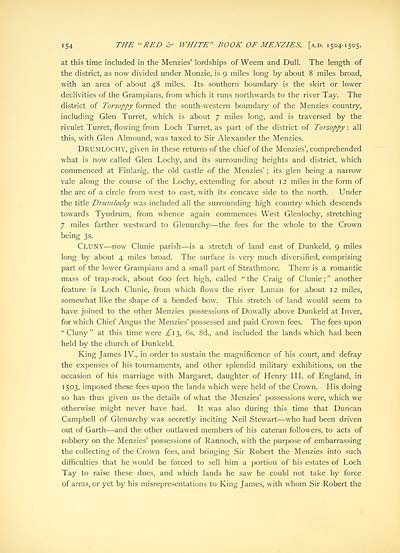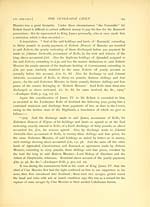Red and white book of Menzies
(214) Page 154
Download files
Complete book:
Individual page:
Thumbnail gallery: Grid view | List view

1 54 THE "RED &•> WHITE" BOOK OF MENZIES. [a.d. 1504-1505.
at this time included in the Menzies' lordships of Weem and Dull. The length of
the district, as now divided under Monzie, is 9 miles long by about 8 miles broad,
with an area of about 48 miles. Its southern boundary is the skirt or lower
declivities of the Grampians, from which it runs northwards to the river Tay. The
district of Torsoppy formed the south-western boundary of the Menzies country,
including Glen Turret, which is about 7 miles long, and is traversed by the
rivulet Turret, flowing from Loch Turret, as part of the district of Torsoppy : all
this, with Glen Almound, was taxed to Sir Alexander the Menzies.
Drumlochy, given in these returns of the chief of the Menzies', comprehended
what is now called Glen Lochy, and its surrounding heights and district, which
commenced at Finlarig, the old castle of the Menzies' ; its glen being a narrow
vale along the course of the Lochy, extending for about 12 miles in the form of
the arc of a circle from west to east, with its concave side to the north. Under
the title Drumlochy was included all the surrounding high country which descends
towards Tyndrum, from whence again commences West Glenlochy, stretching
7 miles farther westward to Glenurchy — the fees for the whole to the Crown
being 3s.
Cluny — now Clunie parish — is a stretch of land east of Dunkeld, 9 miles
long by about 4 miles broad. The surface is very much diversified, comprising
part of the lower Grampians and a small part of Strathmore. There is a romantic
mass of trap-rock, about 600 feet high, called " the Craig of Clunie ; " another
feature is Loch Clunie, from which flows the river Lunan for about 12 miles,
somewhat like the shape of a bended bow. This stretch of land would seem to
have joined to the other Menzies possessions of Dowally above Dunkeld at Inver,
for which Chief Angus the Menzies' possessed and paid Crown fees. The fees upon
"Cluny" at this time were .£13, 6s. 8d., and included the lands which had been
held by the church of Dunkeld.
King James IV., in order to sustain the magnificence of his court, and defray
the expenses of his tournaments, and other splendid military exhibitions, on the
occasion of his marriage with Margaret, daughter of Henry III. of England, in
1503, imposed these fees upon the lands which were held of the Crown. His doing
so has thus given us the details of what the Menzies' possessions were, which we
otherwise might never have had. It was also during this time that Duncan
Campbell of Glenurchy was secretly inciting Neil Stewart — who had been driven
out of Garth — and the other outlawed members of his cateran followers, to acts of
robbery on the Menzies' possessions of Rannoch, with the purpose of embarrassing
the collecting of the Crown fees, and bringing Sir Robert the Menzies into such
difficulties that he would be forced to sell him a portion of his estates of Loch
Tay to raise these dues, and which lands he saw he could not take by force
of arms, or yet by his misrepresentations to King James, with whom Sir Robert the
at this time included in the Menzies' lordships of Weem and Dull. The length of
the district, as now divided under Monzie, is 9 miles long by about 8 miles broad,
with an area of about 48 miles. Its southern boundary is the skirt or lower
declivities of the Grampians, from which it runs northwards to the river Tay. The
district of Torsoppy formed the south-western boundary of the Menzies country,
including Glen Turret, which is about 7 miles long, and is traversed by the
rivulet Turret, flowing from Loch Turret, as part of the district of Torsoppy : all
this, with Glen Almound, was taxed to Sir Alexander the Menzies.
Drumlochy, given in these returns of the chief of the Menzies', comprehended
what is now called Glen Lochy, and its surrounding heights and district, which
commenced at Finlarig, the old castle of the Menzies' ; its glen being a narrow
vale along the course of the Lochy, extending for about 12 miles in the form of
the arc of a circle from west to east, with its concave side to the north. Under
the title Drumlochy was included all the surrounding high country which descends
towards Tyndrum, from whence again commences West Glenlochy, stretching
7 miles farther westward to Glenurchy — the fees for the whole to the Crown
being 3s.
Cluny — now Clunie parish — is a stretch of land east of Dunkeld, 9 miles
long by about 4 miles broad. The surface is very much diversified, comprising
part of the lower Grampians and a small part of Strathmore. There is a romantic
mass of trap-rock, about 600 feet high, called " the Craig of Clunie ; " another
feature is Loch Clunie, from which flows the river Lunan for about 12 miles,
somewhat like the shape of a bended bow. This stretch of land would seem to
have joined to the other Menzies possessions of Dowally above Dunkeld at Inver,
for which Chief Angus the Menzies' possessed and paid Crown fees. The fees upon
"Cluny" at this time were .£13, 6s. 8d., and included the lands which had been
held by the church of Dunkeld.
King James IV., in order to sustain the magnificence of his court, and defray
the expenses of his tournaments, and other splendid military exhibitions, on the
occasion of his marriage with Margaret, daughter of Henry III. of England, in
1503, imposed these fees upon the lands which were held of the Crown. His doing
so has thus given us the details of what the Menzies' possessions were, which we
otherwise might never have had. It was also during this time that Duncan
Campbell of Glenurchy was secretly inciting Neil Stewart — who had been driven
out of Garth — and the other outlawed members of his cateran followers, to acts of
robbery on the Menzies' possessions of Rannoch, with the purpose of embarrassing
the collecting of the Crown fees, and bringing Sir Robert the Menzies into such
difficulties that he would be forced to sell him a portion of his estates of Loch
Tay to raise these dues, and which lands he saw he could not take by force
of arms, or yet by his misrepresentations to King James, with whom Sir Robert the
Set display mode to:
![]() Universal Viewer |
Universal Viewer | ![]() Mirador |
Large image | Transcription
Mirador |
Large image | Transcription
Images and transcriptions on this page, including medium image downloads, may be used under the Creative Commons Attribution 4.0 International Licence unless otherwise stated. ![]()
| Histories of Scottish families > Red and white book of Menzies > (214) Page 154 |
|---|
| Permanent URL | https://digital.nls.uk/96655300 |
|---|
| Description | A selection of almost 400 printed items relating to the history of Scottish families, mostly dating from the 19th and early 20th centuries. Includes memoirs, genealogies and clan histories, with a few produced by emigrant families. The earliest family history goes back to AD 916. |
|---|

